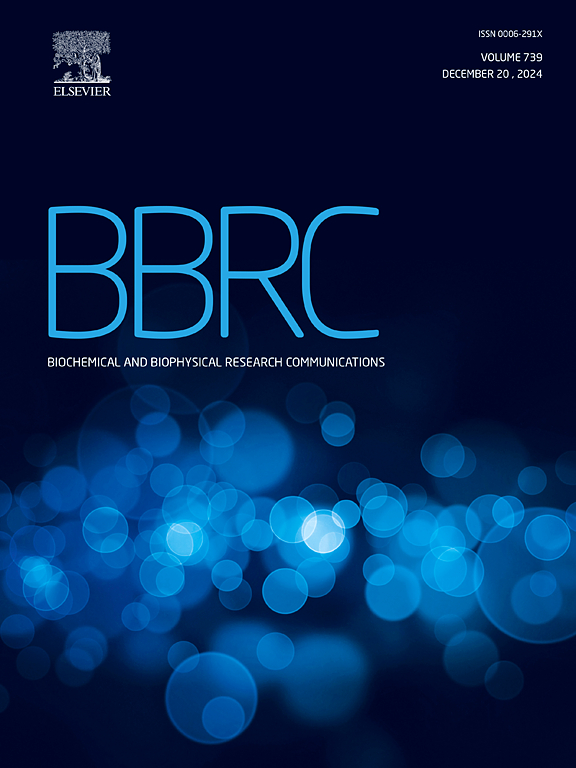Shp2 regulates the trophoblast cell cycle progression through p53-p21 pathway modulation
IF 2.5
3区 生物学
Q3 BIOCHEMISTRY & MOLECULAR BIOLOGY
Biochemical and biophysical research communications
Pub Date : 2025-06-14
DOI:10.1016/j.bbrc.2025.152209
引用次数: 0
Abstract
Normal trophoblast cells proliferation and migration are crucial for placental development. Dysfunction in these processes is closely linked to pregnancy-related diseases, such as preeclampsia (PE) and fetal growth restriction (FGR). This study aimed to explore the role of Src homology 2 domain-containing protein tyrosine phosphatase 2 (Shp2) in regulating trophoblast cell HTR-8/SVneo (HTR8) functions and its underlying mechanisms. By using a specific Shp2 inhibitor (SHP099) and lentivirus-mediated Shp2 knockdown combined with transcriptome sequencing, we found that Shp2 inactivation significantly inhibited HTR8 proliferation by inducing G0/G1 cell cycle arrest and reduced migratory/invasive capacities. The transcriptomic study revealed that Shp2 knockdown in HTR8 cells significantly upregulated p53 pathway downstream genes (CDKN1A, MDM2, etc.). Western blot results showed that Shp2 downregulation increased p21 protein levels, suggesting that Shp2 probably maintains cell cycle progression by suppressing the p53-p21 axis. Both pharmacological inhibition and genetic knockdown of Shp2 modulated Erk1/2 and Akt activities, indicating its roles in trophoblast functions through MAPK and PI3K-Akt signaling. This study provides new insights into the molecular mechanisms governing trophoblast biology and potential therapeutic targets for placental disorders.
Shp2通过p53-p21通路调节滋养细胞周期进程
正常滋养细胞的增殖和迁移对胎盘发育至关重要。这些过程的功能障碍与妊娠相关疾病密切相关,如先兆子痫(PE)和胎儿生长受限(FGR)。本研究旨在探讨Src同源2结构域蛋白酪氨酸磷酸酶2 (Shp2)在调节滋养细胞HTR-8/SVneo (HTR8)功能中的作用及其机制。通过使用特异性Shp2抑制剂(SHP099)和慢病毒介导的Shp2敲低结合转录组测序,我们发现Shp2失活通过诱导G0/G1细胞周期阻滞和降低迁移/侵袭能力显著抑制HTR8的增殖。转录组学研究发现,HTR8细胞中Shp2敲低可显著上调p53通路下游基因(CDKN1A、MDM2等)。Western blot结果显示,Shp2下调可增加p21蛋白水平,提示Shp2可能通过抑制p53-p21轴维持细胞周期进程。药理抑制和基因敲低Shp2均可调节Erk1/2和Akt活性,表明其通过MAPK和PI3K-Akt信号通路参与滋养细胞功能。这项研究为滋养细胞生物学调控分子机制和胎盘疾病的潜在治疗靶点提供了新的见解。
本文章由计算机程序翻译,如有差异,请以英文原文为准。
求助全文
约1分钟内获得全文
求助全文
来源期刊
CiteScore
6.10
自引率
0.00%
发文量
1400
审稿时长
14 days
期刊介绍:
Biochemical and Biophysical Research Communications is the premier international journal devoted to the very rapid dissemination of timely and significant experimental results in diverse fields of biological research. The development of the "Breakthroughs and Views" section brings the minireview format to the journal, and issues often contain collections of special interest manuscripts. BBRC is published weekly (52 issues/year).Research Areas now include: Biochemistry; biophysics; cell biology; developmental biology; immunology
; molecular biology; neurobiology; plant biology and proteomics

 求助内容:
求助内容: 应助结果提醒方式:
应助结果提醒方式:


